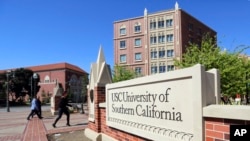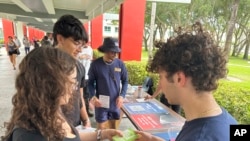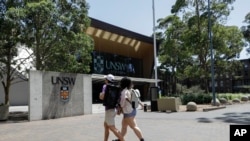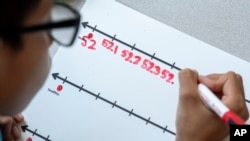Student Union
Free USC Tuition to Students With $80K or Less Family Income

The University of Southern California will phase in free tuition for undergraduate students from families with an annual income of $80,000 or less, USC President Carol L. Folt announced Thursday.
As part of the initiative, ownership of a home will not be counted in determining a student's financial need to attend the Los Angeles private college with 20,500 undergraduates, where tuition and living expenses are above $77,000 annually.
“We're opening the door wider to make a USC education possible for talented students from all walks of life,'' Folt said in a statement.
The changes will be phased in beginning with first-year students entering USC in the fall of 2020 and the spring of 2021, USC said.
The university also said it will increase undergraduate financial aid by more than $30 million annually. When fully implemented, the expansion will allow USC to provide stronger financial assistance to more than 4,000 students every year.
An undergraduate's estimated full-time, two-semester tuition for 2019-2020 is $57,256, according to USC's cost and financial aid website.
Adding fees, housing, meals, books, supplies, transportation and miscellaneous costs boosts the total to $77, 459. For students living with parents or relatives the total estimate is $64,715.
In comparison, the estimated annual average cost for a California resident undergraduate living on campus at the nine public University of California colleges is $36,100. The cost for a student living off campus averages $33,200.
According to USC, two-thirds of its undergraduates receive financial aid and more than 21% of undergraduates are from low-income families.
In all, USC's undergraduate students each year receive more than $640 million in awards from all sources for tuition and expenses. More than half of the total is from USC grants and scholarships.
“With this new initiative, we will be even better positioned to recruit students from all backgrounds and strengthen the USC experience for everyone,'' said USC Provost Charles F. Zukoski.
Folt, the former chancellor of the University of North Carolina at Chapel Hill, became USC's president last year as the university dealt with a series of major scandals, including the college admissions bribery case.
That scandal followed allegations that the school ignored complaints of widespread sexual misconduct by a longtime campus gynecologist and an investigation into a medical school dean accused of smoking methamphetamine with a woman who overdosed.
See all News Updates of the Day
Billionaire gives graduates cash, but asks them to give, too

During a recent graduation ceremony at University of Massachusetts Dartmouth, a Boston billionaire gave each member of the graduating class $1,000.
As Jenna Russell reports in The New York Times, the gift came with a catch: The philanthropist asked the students to give half the money to any good cause. (May 2024)
America’s future diplomats forgoing foreign travel

U.S. students who want federal jobs as diplomats are skipping opportunities to study abroad or develop foreign contacts, according to a column in Foreign Policy.
Elizabeth Braw explains that government workers need security clearances, and students don’t want to complicate the process. Ultimately, their lack of expertise could hurt the nation. (May 2024)
Most US students are recovering from pandemic setbacks, but millions lag

On one side of the classroom, students circled teacher Maria Fletcher and practiced vowel sounds. In another corner, children read together from a book. Scattered elsewhere, students sat at laptop computers and got reading help from online tutors.
For the third graders at Mount Vernon Community School in Virginia, it was an ordinary school day. But educators were racing to get students learning more, faster, and to overcome setbacks that have persisted since schools closed for the COVID-19 pandemic four years ago.
America's schools have started to make progress toward getting students back on track. But improvement has been slow and uneven across geography and economic status, with millions of students — often those from marginalized groups — making up little or no ground.
Nationally, students made up one-third of their pandemic losses in math during the past school year and one-quarter of the losses in reading, according to the Education Recovery Scorecard, an analysis of state and national test scores by researchers at Harvard and Stanford.
But in nine states, including Virginia, reading scores continued to fall during the 2022-23 school year after previous decreases during the pandemic.
Clouding the recovery is a looming financial crisis. States have used some money from the historic $190 billion in federal pandemic relief to help students catch up, but that money runs out later this year.
"The recovery is not finished, and it won't be finished without state action," said Thomas Kane, a Harvard economist behind the scorecard. "States need to start planning for what they're going to do when the federal money runs out in September. And I think few states have actually started that discussion."
Virginia lawmakers approved an extra $418 million last year to accelerate recovery. Massachusetts officials set aside $3.2 million to provide math tutoring for fourth and eighth grade students who are behind grade level, along with $8 million for literacy tutoring.
But among other states with lagging progress, few said they were changing their strategies or spending more to speed up improvement.
Virginia hired online tutoring companies and gave schools a "playbook" showing how to build effective tutoring programs. Lisa Coons, Virginia's superintendent of public instruction, said last year's state test scores were a wake-up call.
"We weren't recovering as fast as we needed," Coons said in an interview.
U.S. Education Secretary Miguel Cardona has called for states to continue funding extra academic help for students as the federal money expires.
"We just can't stop now," he said at a May 30 conference for education journalists. "The states need to recognize these interventions work. Funding public education does make a difference."
In Virginia, the Alexandria district received $2.3 million in additional state money to expand tutoring.
At Mount Vernon, where classes are taught in English and Spanish, students are divided into groups and rotate through stations customized to their skill level. Those who need the most help get online tutoring. In Fletcher's classroom, a handful of students wore headsets and worked with tutors through Ignite Learning, one of the companies hired by the state.
With tutors in high demand, the online option has been a big help, Mount Vernon principal Jennifer Hamilton said.
"That's something that we just could not provide here," she said.
Ana Marisela Ventura Moreno said her 9-year-old daughter, Sabrina, benefited significantly from extra reading help last year during second grade, but she's still catching up.
"She needs to get better. She's not at the level she should be," the mother said in Spanish. She noted the school did not offer the tutoring help this year, but she did not know why.
Alexandria education officials say students scoring below proficient or close to that cutoff receive high-intensity tutoring help and they have to prioritize students with the greatest needs. Alexandria trailed the state average on math and reading exams in 2023, but it's slowly improving.
More worrying to officials are the gaps: Among poorer students at Mount Vernon, just 24% scored proficient in math and 28% hit the mark in reading. That's far lower than the rates among wealthier students, and the divide is growing wider.
Failing to get students back on track could have serious consequences. The researchers at Harvard and Stanford found communities with higher test scores have higher incomes and lower rates of arrest and incarceration. If pandemic setbacks become permanent, it could follow students for life.
The Education Recovery Scorecard tracks about 30 states, all of which made at least some improvement in math from 2022 to 2023. The states whose reading scores fell in that span, in addition to Virginia, were Nevada, California, South Dakota, Wyoming, Indiana, Oklahoma, Connecticut and Washington.
Only a few states have rebounded to pre-pandemic testing levels. Alabama was the only state where math achievement increased past 2019 levels, while Illinois, Mississippi and Louisiana accomplished that in reading.
In Chicago Public Schools, the average reading score went up by the equivalent of 70% of a grade level from 2022 to 2023. Math gains were less dramatic, with students still behind almost half a grade level compared with 2019. Chicago officials credit the improvement to changes made possible with nearly $3 billion in federal relief.
The district trained hundreds of Chicago residents to work as tutors. Every school building got an interventionist, an educator who focuses on helping struggling students.
The district also used federal money for home visits and expanded arts education in an effort to reengage students.
"Academic recovery in isolation, just through 'drill and kill,' either tutoring or interventions, is not effective," said Bogdana Chkoumbova, the district's chief education officer. "Students need to feel engaged."
At Wells Preparatory Elementary on the city's South Side, just 3% of students met state reading standards in 2021. Last year, 30% hit the mark. Federal relief allowed the school to hire an interventionist for the first time, and teachers get paid to team up on recovery outside working hours.
In the classroom, the school put a sharper focus on collaboration. Along with academic setbacks, students came back from school closures with lower maturity levels, principal Vincent Izuegbu said. By building lessons around discussion, officials found students took more interest in learning.
"We do not let 10 minutes go by without a teacher giving students the opportunity to engage with the subject," Izuegbu said. "That's very, very important in terms of the growth that we've seen."
Olorunkemi Atoyebi was an A student before the pandemic, but after spending fifth grade learning at home, she fell behind. During remote learning, she was nervous about stopping class to ask questions. Before long, math lessons stopped making sense.
When she returned to school, she struggled with multiplication and terms such as "dividend" and "divisor" confused her.
While other students worked in groups, her math teacher took her aside for individual help. Atoyebi learned a rhyming song to help memorize multiplication tables. Over time, it began to click.
"They made me feel more confident in everything," said Atoyebi, now 14. "My grades started going up. My scores started going up. Everything has felt like I understand it better."
How to get students to ask for help

Colleges and universities have programs to help students adjust to the challenges of higher education but getting students to ask for help is a problem in itself.
In Inside Higher Ed, Cecilia Santiago-González and Zoe Lance offer tips for creating a culture where asking for help is part of the process. (May 2024)
- By Phil Mercer
Australian, Chinese university chiefs meet in Adelaide

Australian university leaders held talks Wednesday with their Chinese counterparts over the Canberra government’s plans to cut the number of international students. Australia has said the reductions will ease the stress on housing and reduce immigration.
Representatives from the Group of Eight Universities, which represents large research-intensive institutions in Australia, met Wednesday in Adelaide with leaders from the China Education Association for International Exchange.
The Chinese delegation included senior officials from 22 leading research-intensive universities in China.
In a joint statement, the two groups said that “our research and education links not only deliver enormous economic and social benefits for both countries, but also foster enduring people-to-people ties.”
The talks focused on “constructive dialogue focused on challenges and opportunities around university research in a fast-evolving, globalized world.”
One major challenge is Australia’s plans to cap the number of international students it allows into the country to relieve pressure on housing and rental accommodation in the major cities. It is part of a broader effort to reduce immigration.
In 2023, official data showed that 787,000 international students studied in Australia, exceeding levels seen before the COVID-19 pandemic.
However, the tertiary sector says plans to shut out some foreign students would cost the economy billions of dollars.
Vicki Thompson is the chief executive of the Group of Eight Universities. She told the Australian Broadcasting Corp. Wednesday that it is unclear how far international student numbers would be cut.
“At the moment there is a lot of unknowns about what this will actually mean. We are in very good discussions with government, though. They certainly understand the impact that our international education sector has on tourism, on the economy. So, you know, they do not want to bust it either. It is just how can we come to, I guess, a compromise position where, you know, we do not damage one of our most successful export markets,” she said.
Most overseas students in Australia come from China, India, Nepal, the Philippines and Vietnam, according to government data.
Under the government’s plans, colleges and universities would have to provide purpose-built accommodation for international students if they wanted to exceed the caps on numbers.
Specific quotas for foreign students, however, have not yet been made public by the Canberra government.
Australia’s plan to curb the number of students from other countries is expected to be discussed when Chinese Premier Li Qiang meets Australian Prime Minister Anthony Albanese in Canberra next month.







